As far as natural solutions for saltwater fish tanks go, there’s not much that is cooler than refugiums as a form of aquarium filtration.

For optimal efficiency in such a setup, you’ll need to provide the best LED refugium light for your chosen form of macroalgae to grow, usually Chaeto. This way the plant can grow quickly and suck the excess nutrients from the water.
Nice, after learning that it should be as simple as browsing for some light bulbs, popping them in, and watching our plants get huge.
The problem is, as always, a great number of questions start popping up with little recourse to answer them.
Is a PAR38 bulb better than a classical LED architecture? Does the fixture need to be waterproof or you can pull this one off with a normal grow light?
The sump lights range from premium pricing to cheap ones, but what are you compromising with if you get a more inexpensive one? What would be an adequate choice of light for a small nano refugium? You don’t want to overwhelm the macroalgae and bleach it.
What should you look for when choosing the best lighting for a sump or its refugium?
Let’s get to it.
The 6 Best Refugium Lights for Growing Chaeto Algae
For a quick overview of the best LED refugium lights reviewed here take a look at this comparison chart:
| Light name: | Recommended for: | Price Bracket: |
|---|---|---|
| 1. ACKE LED Grow Light | nano refugium | $ |
| 2. GrowStar UFO 150W LED | small to medium sized refugiums | $ |
| 3. AI Prime Fuge | medium refugiums | $$$$ |
| 4. Kessil H80 Tuna Flora Refugium LED | nano refugiums | $$$ |
| 5. Waterproof CF Grow | large refugiums | $$ |
| 6. Tunze Eco Chic 8831 | nano to medium refugiums | $$ |
A Buyer’s guide on LED lighting and its role in growing macroalgae
In my trials and tribulations with the macroalgae Chaetomorpha, I found that there’s a huge difference in the amount of growth I get when using a proper setup, versus just any old thing.
That being said, it’s among the hardy species of saltwater aquarium plants; it will grow as long as it is somewhat cared for.
But, to get decent results with Chaetomorpha, and trust me there is a big difference between optimal and suboptimal growth, let’s go over a quick beginner guide:
1. Controllability of Your Lighting Fixture is Helpful
Old school setups wish they had this level of customization.
If you have the option, an LED light system that allows you to control its output is ideal:
I strongly recommend an LED grow system that allows you to control specific light output for Chaetomorpha. This includes tweaking the right spectral quality and intensity for better water penetration. You can seriously hone in on the exact amount of light and schedule that best suits the needs of your refugium and your macroalgae.
This was one of the biggest game-changers for me when I moved to LED light setups.
Another thing to mention is that LEDs can be turned down but can’t be turned up past a certain amount, so you’ll need something that packs a decent punch, but is, ideally, dimmable.
Don’t let this be the only thing you look for when purchasing a grow light for your refugium.
However, all things being equal, it’s a preferable feature for your new lighting.
2. Size and Style are Important
Way back when I was initially getting into LED lights for my refugium, I didn’t really pay a lot of attention to what was going to sit well with my aquarium.
This gave me endless headaches further down the line.
So I’d advise that you make sure you’re good with the size and style of your refugium’s LED lights:
The gist of where the problems lie is when you have a highly focused and small LED light. These tend to put out enough light but not in a wide enough area.
This can be good in small refugiums or in certain aquarium setups, but it’s not great if you’re trying to grow in a wide space. You’ll just end up with one clump of your macroalgae growing way faster than the rest.
Furthermore, certain LED systems require an area to hang from above your refugium. This in itself can become a problem if you’re like me and keep it out in the open.
You can also opt for something like the Par38 style of bulbs, which screw into sockets and allow for the conversion of hoods into an LED system.
I like these and they tend to have a great light spread.
Unfortunately, depending on the socket they are screwed into, it can be suboptimal for the bulbs. This could lead to a quicker burnout than they are rated for.
Par38 bulbs are still a good option and are readily available for people with previous refugium light setups.
3. Remember That Kelvin Ratings are a Marketing Gimmick
Not all LEDs produce the same type of light.
In layman’s terms, CCT is an artificially unified system that all lighting manufacturers agreed on in regards to light color.
See, when a black body burns at a certain temperature it emits a certain color of light.
High burning temperatures produce blue, whereas lower temperatures lean more toward red.
It has been established that defined temperatures on the Kelvin scale correspond to defined colors.
Our sun produces white-ish light and burns at approximately 5700 K.
And here’s the place we should discuss manufactured lighting.
See, if you buy a fixture that produces 5700 K of light it would mean that it only resembles that color temperature.
The bulb itself will not literally burn at a staggering 5700 K of temperature.
This is where CCT comes into play.
In general, CCT is used to determine the chromaticity of the light source and how it appears to the human eye.
“Warm” light means something that leans on the yellow to the red range whereas “cool” means more white or blue-ish.
Here’s a visual representation of that:
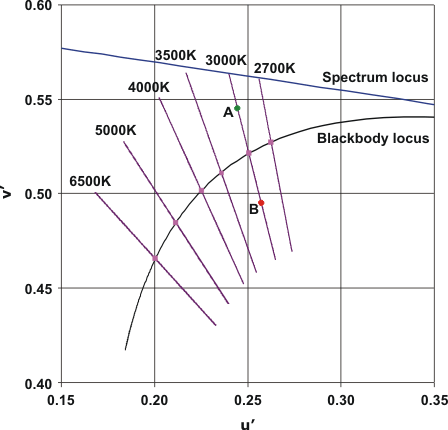
As you can see from this rather complicated graph, point A and point B have the exact same CCT of 3000 K, however, they would appear very different to the human eye.
Point A would light up in green whereas point B would have a purple-white hue.
That being said, here’s how Kelvin ratings affect the growth of macroalgae in refugiums:
For macroalgae to thrive in a refugium you need to provide it with the right spectrum wavelengths and not Kelvin ratings.
Kelvin measurements are a very crude estimation of spectral color and not quality.
You’ll know that your 2000 K bulb produces light in the yellow-ish spectrum, but you’ll have no idea what that means to your Chaeto.
LED lights can employ specific light-emitting diodes with defined spectral ranges, which is why they have dominated the grow light industry in recent years.
In short, with LED grow lights emphasis is put on the right wavelength for plant growth and not on what the emitted color appears to us, humans.
Anyway, the first refugium I tried an LED light in, I almost gave up.
I had the tank balanced right, the nitrates were perfect, and I was using a tried and true algae food, but my growth was really not great.
Turns out, I made a really basic beginner’s mistake because I didn’t understand LEDs at the time.
The lights in my refugium were mostly producing white light, which is the most readily visible to our eyes.
Chaetomorpha actually grows best in the blue and red range of light.
Full-spectrum lamps may do the job as well, but not nearly as good as a predominantly red diode LED light fixture.
5000 to 6000 K will grow macroalgae, but to get the hulking behemoths that are possible you need to aim for the proper spectrum.
Be doubly sure to check the range of spectrums your lights of choice are producing.
In my reviews below I made sure to only list lights with the correct spectral quality, so you don’t need to spend additional time researching that.
This brings me to the next section of interest…
4. Finding the Best Grow Light Spectrum for Chaetomorpha
Michigan State University decided to conduct an eye-opening experiment to show which exact light spectrum has the most impact on plant growth.
Chaetomorpha is a green macroalgae that uses photosynthesis, so it makes sense that it would benefit from these same spectra.
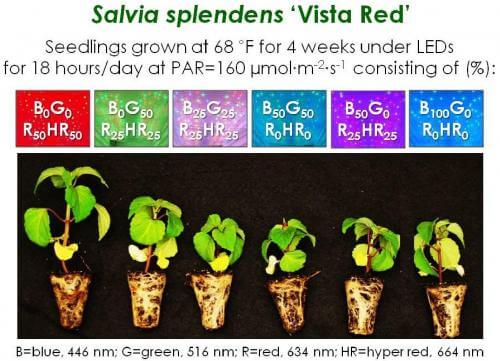
As seen in the picture, the most growth was achieved through the combination of the red and hyper red spectrum.
Another conclusion we could draw from this experiment is that anything that includes 25% or more blue light performed visibly worse than the combination of purely green and red.
Blue is essential for a green plant’s health by improving leaf density, but excessive quantities of it will suppress extension growth.
Having said that, the best light spectrum for growing Chaetomorpha macroalgae would be:
- No less than 50% of total red incoming light in the wavelength range of 630 to 700 nanometers.
- Between 10% and 15% of total blue incoming light in the wavelength range of 435 to 495 nanometers.
- Around 30% of total green incoming light that’s in the wavelength range of 500 to 580 nanometers.
Author’s note: It’s important to clarify that these are not intensities, but the total proportions of the light spectrum you’re basking your macroalgae in. So 50% of total red incoming light does not necessarily mean having your red channel at 50% intensity. If you want to have your lighting’s red channel at 100% intensity then you should follow the proportions of other channels’ intensities accordingly. For example, having your red channel at 100% intensity would mean having your green channel at 60% intensity (30 green to 50 red is the same as 60 green to 100 red). Blue light in that scenario should be what 10 is to 50 – so around 20% intensity.
Anyway, ideally, an LED grow light for a refugium tank that houses Chaeto would contain a majority of red diodes stimulating the growth, and a very few blue ones to support vegetative density.
When you browse grow lights you’ll rarely see ones that contain green diodes, however.
As shown in the experiment above the green spectrum can be successfully substituted with an abundance of red wavelengths when it comes to growth.
For the sake of knowledge, “pure” white light LED diodes contain a decent amount of “green” and peak at around 550 nanometers with another spike in the blue part of the spectrum.
Here’s a picture representing the spectrum in a white light LED diode:
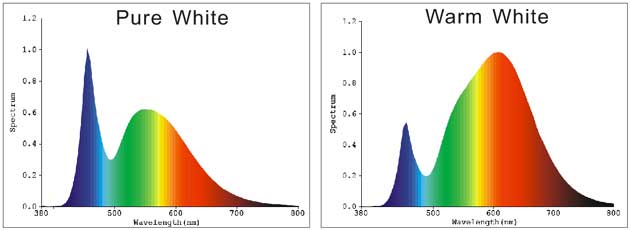
The peak of 550 nanometers in pure white LEDs falls within the green wavelength range on the electromagnetic spectrum. The warm white diodes also have a great amount of this wavelength spectrum, but peak at red (as seen in the picture above).
When it comes to growing Chaeto this would translate to a potential alternative combination of diodes which could produce good results with a majority of red LED chips and a couple of warm white ones, where the latter will supply the blue and green spectral ranges in adequate proportions.
I don’t have a lot of personal experience with the red and warm white combination, but I have seen solid proof of success with red plus blue diodes in my reef-keeping years.
Chaetomorpha has a few requirements that need to be met to grow, but to grow well is another story.
The best grow lights stay around the red spectrum for Chaeto and will sometimes allow for customization on each separate light channel (read “color”).
In my reviews below I made sure to only select lights that would significantly boost the photosynthetic rates of macroalgae.
5. Consider Light Penetration
Different water penetrations of light are appropriate for different tanks.
Basically what happens is the water refracts a fair amount of light, even in seemingly bright setups. So consequently, plants in deeper sections of the tank can end up getting less than you might expect.
There are a few simple things to remember while purchasing LED lighting in regards to its water penetration:
Both the refugium’s depth and water clarity have a direct impact on how much light reaches the macroalgae. The spectrum output also plays a role in water penetration, as shorter wavelengths have deeper water penetration than longer ones.
Read – blue reaches deeper in water than red.
Generally, the fixtures I’m reviewing will support any refugium that’s at least 18″ deep.
Red light gets filtered out from the water and has the least penetration from all the photosynthetically active spectrums.
Here’s an illustration of that:

And here’s how this impacts a refugium with macroalgae in it:
Macroalgae falls within its own three categories of red, blue and green macros, with each corresponding to the depth they are seen in the ocean.
Chaetomorpha, in particular, is a green macroalgae, which means it thrives in shallower environments.
This automatically supports the statement that it would benefit the most from the red light spectrum.
6. Wattage is Misleading
Here’s why wattage in LED lighting is not a good benchmark for potential intensity:
You shouldn’t compare them in terms of Watt output.
Newer diodes are very energy efficient, which makes the old “watts per gallon” rule obsolete. Because there are different classes of light-emitting diodes, with some more powerful and energy-efficient than others, the Wattage of LED lights is a really poor benchmark for produced intensity.
And speaking of intensity it’s time to expand on that.
7. The point is to outcompete the algae in the display tank
The following anecdote is something that has happened to me personally but I also heard many others confirm it through their experience.
Say, you have a saltwater aquarium with mainly some cool fish and live rock, and you’re using a rather weak bulb on your refugium, which grows Chaeto decently.
At one point you decide to upgrade the lights in your display tank because you want to get a taste of keeping real corals.
You go ahead and buy a more expensive, strong LED fixture and stuff your tank with beautiful corals.
Not long after your main display tank gets algae, and the Chaeto in your refugium either dies out or stops growing altogether.
Can you guess what happened?
Macroalgae should be able to outcompete other types of algae in the display tank and also “scrub” the excess nutrients from the water. For this to happen your refugium needs a light fixture with adequate intensity.
The ones I’m about to review provide powerful output, despite being low Watts or leaning towards the cheaper side of things.
What’s the Best LED Refugium Lighting to Grow Colossal Chaeto?
To get the best for your Chaetomorpha and supply it with an adequate refugium light you should know that options vary according to setup. However, I will still eliminate the choices down quite a bit to save you time.
We can take a look at the various specs and offerings of some of the leading grow lights on the market and we can narrow down what each of them brings to the table.
Here are the best LED refugium lights to grow massive macroalgae:
1. ACKE LED Grow Light – Best for smaller refugiums on a budget
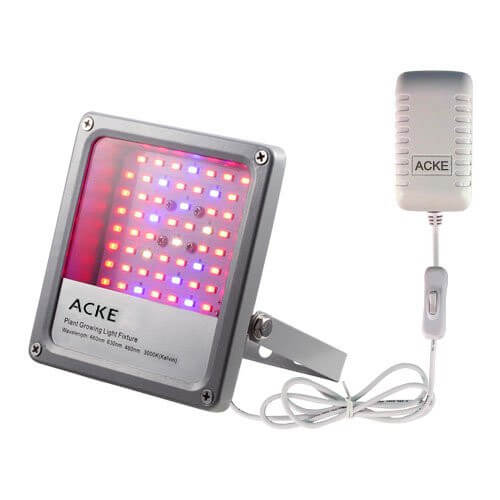
Click here to see the current price + more photos on Amazon.
I like this light. I really do. It’s an awesome little grow light that works amazingly in a nano refugium setup, like a cubicle that’s no more than 40 gallons.
I figured I’d mention this one first due to the fact that in my initial nano tank trial, this thing basically doubled the growth output from where it was previously.
It also is an excellent choice for a sump tank, depending on the size. That’s because the intensity and spectrum of it are nice while it has a low wattage, and produces plenty of light for its own compact size.
It has predominantly red diodes in the 630 and 660 nm wavelengths which is more than ideal for photosynthesis.
It also has a couple of 460 nm blue ones, helping the Chaeto (or any other macroalgae for that matter) to keep its density.
It also has a few warm light ones in the 2700 K range, which further stimulates photosynthesis, as described in the spectrum section above.
Perhaps, this combo of diodes makes this grow light a popular choice for users on your regular reef-keeping forum.
The ACKE LED is one of the best options for a refugium light if you have a smaller tank and would like to keep it inside a reasonable budget, without compromising the growth of your macroalgae.
While this nano LED light did bring the best out of my refugium tank I also liked the look of it.
Made my little tank look like something in the background of Star Trek.
I’d only use it on refugiums that are up to 30 gallons.
There’s no control of output or timer, and it maxes out at a paltry 12 W.
Still, it’s an excellent LED that takes very little space in the sump, just don’t expect a single fixture of these to do the job for refugiums that are larger than 40 gallons or above.
Buy the ACKE LED if you want a cheap but efficient solution for your saltwater aquarium’s filtration.
Advantages:- Rather cheap
- Very energy efficient
- Spectrum is spot on for photosynthesis of green plants and macroalgae
- Effective spread is 15 x 15 inches which is great for the price
- Easy installation
- Compatible with an outlet timer
- WATERPROOF
- No intensity control
2. GrowStar UFO 150W LED – Lots of growth in nano tanks

Click here to see the current price + more photos on Amazon.
Another small LED light here, but in my opinion, this one packs a much bigger punch.
The GrowStar UFO 150 went onto my own refugium, which was a standard 26-gallon piece.
I was drawn to this one as I didn’t have a lot of overhead space on which to hang it and it seemed like a solid deal for the output it was offering.
The spectrum seems to be spot on for what my Chaeto wants.
The blue-red combo on this one really set off my macroalgae’s growth cycle and I, like my friend from before, was dealing with more Chaeto than I knew what to do with.
As far as a nano light for a refugium tank goes I really couldn’t ask for more.
It’s pretty crazy what these small-scale lights are capable of these days.
Plus there’s a long warranty on it, so if it goes out I can get a replacement.
Unfortunately, this one doesn’t have any timer or dimmer on it.
I recommend the GrowStar UFO 150W for anyone on a budget that needs a small, but powerful LED sump light for their refugium.
I have seen this particular lamp being recommended left and right in online reef keeping forums when it comes to cheaper refugium lights.
It’s honestly hard to find a bad experience with the GrowStar.
In fact, here is a macroalgae growth progression of 3 days achieved with the GrowStar UFO 150W:

By Dj City
Advantages:- Perfect spectrum with lots of proven success cases
- Great bang for your buck
- Grows many kinds of macroalgae, including chaetomorpha
- Surprisingly strong for its size
- Quiet fans that keep the lamp cool
- Can be set on a timer
- Spectacular performance in small to medium-sized refugiums
- CREE LED chips (higher quality generation)
- 2 years warranty
- No dimmer / intensity control
- Not waterproof
- Longevity issues may or may not occur (though the warranty covers it, which is cool)
3. AI Prime Fuge – High-End Tech for Medium-Sized Tanks
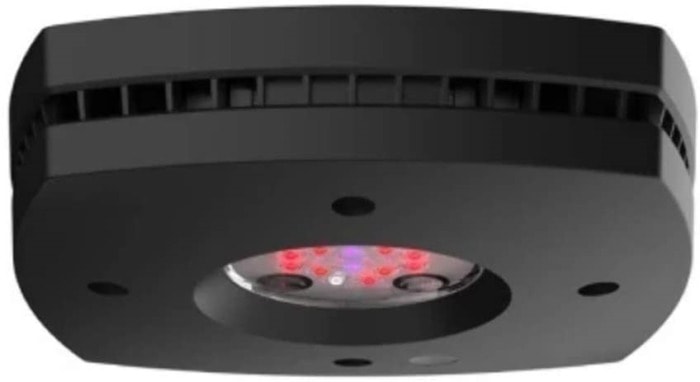
Click here to see the current price + more photos on Amazon.
The AI Prime Fuge is arguably among the best high-end LED lights you could get for your refugium. Though some users can’t justify its price just to grow algae, this light grows Chaeto like a champ.
The first thing I noticed when I first got my hands on it was that it has a ton of red diodes. Ten out of the 14 diodes were, in fact, red. After doing some reading I found out that these are what the manufacturers call “photo red” and “red” diodes.
To me, the spectrum looked pretty optimized at this point, as it got a lot of red, some cool white, and a little UV.
AquaIllumination has always done a good job at researching the spectrum of their LED lights, and the AI Prime Fuge seemed like no exception.
Anyhow, I went ahead and tested the thing on one of my own refugiums at the time (I received it as a gift from my local fish store).
I have to say, it was like my Chaeto immediately reacted to the Prime.
In about 7 days my Chaetomorpha was more than double its starting size, all other things being equal. In about two weeks the Chaeto was filling my refugium to the brink which was basically a 5-fold growth.
The AI Prime Fuge has an effective light spread of 24 inches when it’s mounted at around 12 inches off the water’s surface.
Consider this before going for the purchase as you don’t want too much light spilling outside the tank if you have a smaller refugium.
You can always bring the spotlight closer, however, but this will result in an increase in PAR.
Speaking of which, during my research, I stumbled across some PAR readings for the AI Prime Fuge and it had a pretty impressive performance.
Anyway, I honestly did not expect this much growth so fast. However, AquaIllumination is one of my favorite brands for LED lighting in reef aquariums, so it wasn’t that much of a shock.
Author’s note: There’s a notion about this LED light that it is specifically designed to grow Chaetomorpha macroalgae and nothing else. I haven’t tested the AI Prime Fuge with other types of macroalgae, but I’m sure it will likely grow almost anything well.
Anyhow, another thing I found convenient about this refugium light was that it can be controlled by the default AquaIllumination app. This means that if you’re already using the AquaIllumination Hydra 32 or 54 for your display, you can control all of your aquarium’s lighting with a single app.
Finally, I should mention that the explosive macroalgae growth you get may slightly raise your tank’s PH over time. This is because the Chaeto will suck up a lot of CO2 from the water, so don’t panic if it happens. CO2 content in the water lowers its acidity. Overall, it’s a good sign in the context of crazy Chaetomorpha growth.
Anyway, I recommend getting the AI Prime Fuge if you want to squeeze the maximum potential out of your refugium while having strong, high-end display lights.
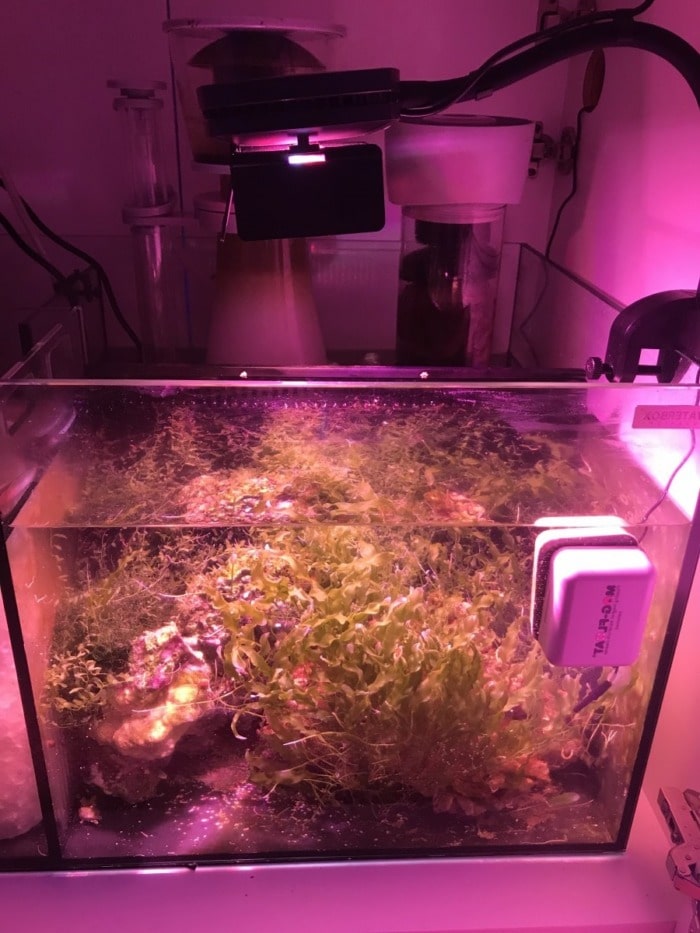
You can see how the AI Prime Fuge grows macroalgae in this reef keeper’s refugium:
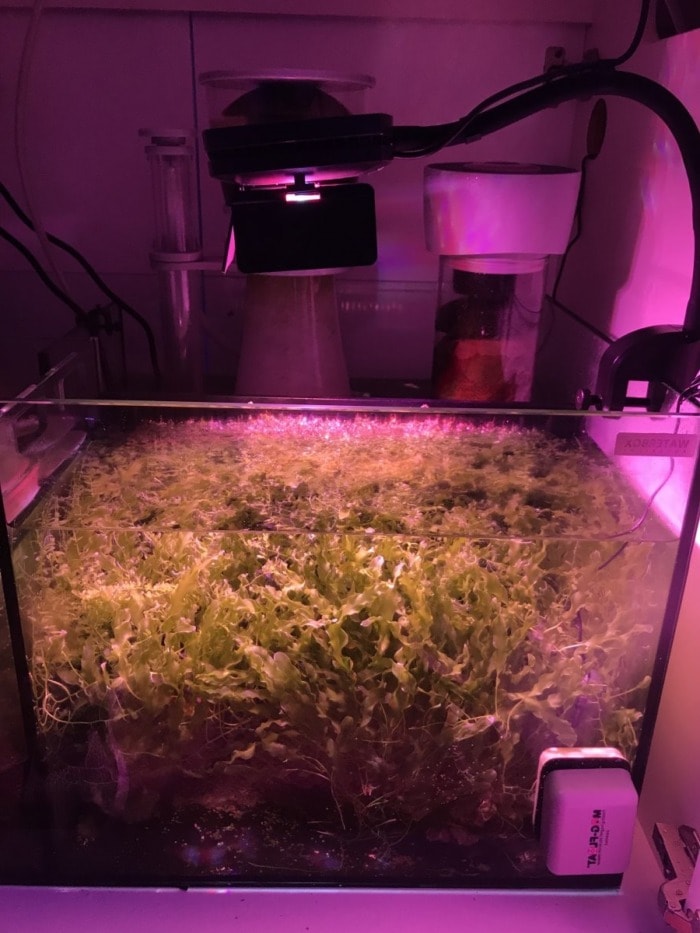
And here’s how much the macroalgae grew in just about 2 weeks:
By Kelsea

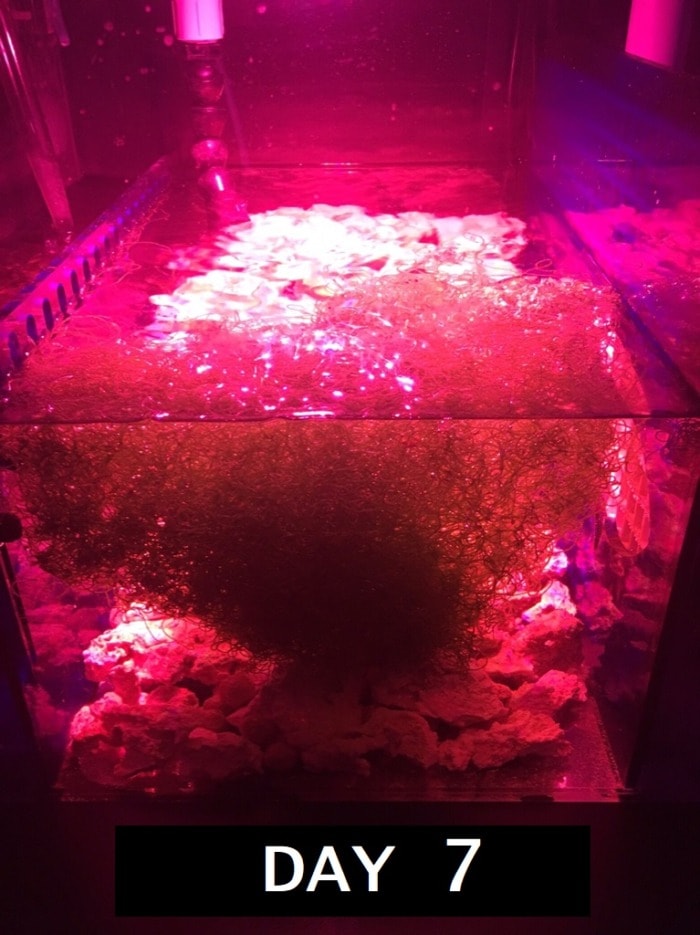

Continuing with the growth progression photos, here’s one month worth of Chaetomorpha growth from another AI Prime user:
By NaH20nerd
Advantages:- Spectrum is fine-tuned to grow Chaeto like crazy
- Hits about 800 PAR at 8 inches, so it’s really powerful
- Can be used with the MyAI app
- Very good effective spread of almost 2 feet
- Fantastic for medium-sized refugiums
- Durable
- Sleek look
- Highly customizable
- Price point is a bit high
- You need to buy the mount separately, which is somehow ridiculous at this price point, in my opinion
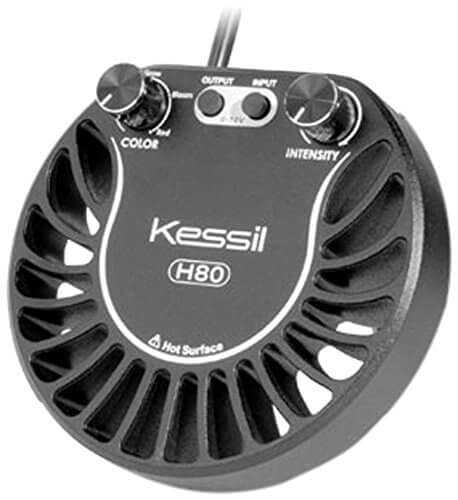
Click here to see the current price + more photos on Amazon.
Kessil is a brand with an established reputation in the world of reef keeping and if you’ve had a saltwater aquarium before you’re probably familiar with their (well deserved) fame.
The Kessil H80 is an excellent choice for anyone looking for an LED light system made specifically for sumps and refugiums.
There’s definitely plenty to like here. Marketed for refugiums, it obviously works equally well as a sump light.
The LED they use is low-wattage, but that’s because the light it’s producing is just in the range for aquatic plants.
Meaning there’s less wasted light that’s not really useful for your Chaeto or coming off your sump.
There’s also a nice control system on the main body of the light that allows you to fine-tune things for your specific needs.
All of this is good, and from what I’ve seen from it the light does its job and it does it well.
The spectral quality is proven to work, not just by us reefers, but also by the Kessil research team.
See, these guys are in the LED lighting industry long before many of the brands listed here.
They have their own research facilities and take the quality of their products very seriously.
Nailing the right spectrum and PAR intensity are two things you don’t have to worry about if you’re going for a Kessil.
The only issues I’ve seen are that sometimes there’s a dud in the batch.
Not exactly sure where the issue lies, and the company is good with returns, but it’s a potential issue.
Another thing that some may consider an issue is pricing.
On top of being a little pricier than most models listed here, you’ll also need to buy the Spectral Kessil controller separately. That is if you’d like to take full advantage of this light’s customization potential.
Aside from that weird business decision, the pricing of the fixture itself is fair. I say this because this is premium refugium lighting with durable components and high-quality LED chips.
With that aside, this is a great light that doesn’t create excess heat or waste energy.
It’s good stuff, and the product is an amazing concept and one of the best out there.
I recommend buying the Kessil H80 if you have a more loose budget for equipping your small refugium with a durable and efficient LED light.
Your Chaeto will thank you by destroying any traces of excess nitrates and phosphates.
Set the mode to “Grow” if you don’t want to play with the settings too much.
Author’s note: When it comes to refugium lighting Kessil also produces the Kessil H160 Tuna Flora and the Kessil A360X Refugium. The latter is a very high-end and overpowered refugium LED light.
To be honest, the A360X is likely the strongest of all the LED lights on this list. I deem it a good buy only if you plan to start a large display refugium. Otherwise, you should either go with the H160 for large non-display refugiums or the H80 for smaller ones.
Here’s a hefty ball of Chaeto grown under a Kessil H80:

By reefbuilder
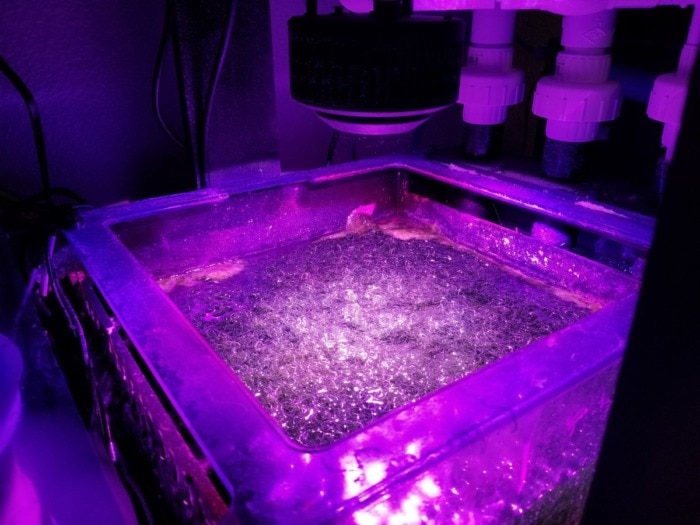
And here’s a refugium full of macroalgae grown with the high-end Kessil A360X Refugium:
By Crashnt24
Advantages:- Durable with a quality build
- Lab-researched spectrum for improved photosynthesis
- Definitely grows Chaeto and really fast at that
- Sleek look
- Silent work
- Fantastic cooling system
- Is customizable and dimmable
- Excellent as a small sump light
- You need to get the Kessil Spectral controller separately to unlock its full customizable potential
- You need to get the gooseneck separately for optimal flexibility when positioning
5. CF Grow 200 W – Flood-type LEDs for a massive yield
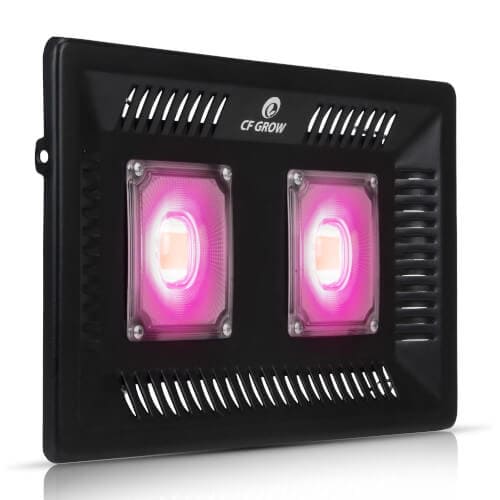
Click here to see the current price + more photos on Amazon.
Loudness. That’s an issue I ran into with a few of the popular grow lights, some of them were louder than my pumps.
Not with this fixture at least. Anyway, the light spectrum of the CF Grow 100W is good for macroalgae, especially Chaetomorpha.
One of the best nano lights I’ve seen and at a budget price, which is the main reason it makes this list.
However, the size of the fixture itself should not mislead you.
The Chaeto in the refugium we tried this on grew like crazy and we’d have to harvest it every 2 weeks or it would literally creep out of the sump.
This fixture uses COB LEDs and it is designed as a floodlight as opposed to spotlights.
This means way better and more balanced spread, making it ideal for massive refugiums as long as you position it at least 12″ from the surface.
There are a couple of things to be aware of with this light, however.
I made this mistake initially, putting it on a compact refugium with very little shelf space above it.
It got a bit hotter than I expected.
Being waterproof helps with prolonging the life of the product by a significant margin, as long as there’s a heat sink of some sort in your cabinet.
But if you keep that in mind you’re looking at a really solid nano LED light for a sump setup and a really good price point.
I recommend this LED light for those of you who have a tighter budget but want to achieve excellent Chaeto growth in their large refugium.
Just make sure that the produced warmth goes somewhere and does not circulate inside your sump’s cabinet.
Here’s what the 200W CF Grow is capable of over a large refugium:
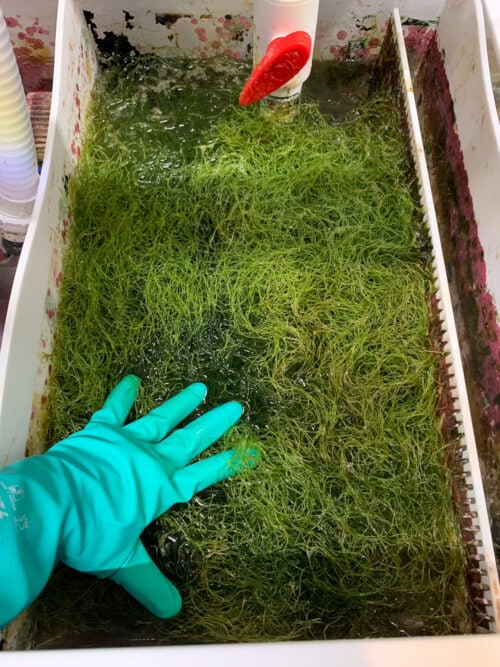
By wangspeed
Note that the user from the photo did install a couple of heatsinks on the fixture but claims that it may have been unnecessary.
Advantages:- Budget-friendly given what you get in return
- COB LED flood-type of light, which means enormous spread
- An adequate choice for large refugiums on a budget
- Operates silently because there are no fans running
- Can be set on a timer
- WATERPROOF
- Spectral quality is top-notch
- Gets rather warm (you could plug a couple of heatsinks on it, though manufacturers claim that it’s normal)
- Not dimmable
6. Tunze Eco Chic 8831 – The versatile option
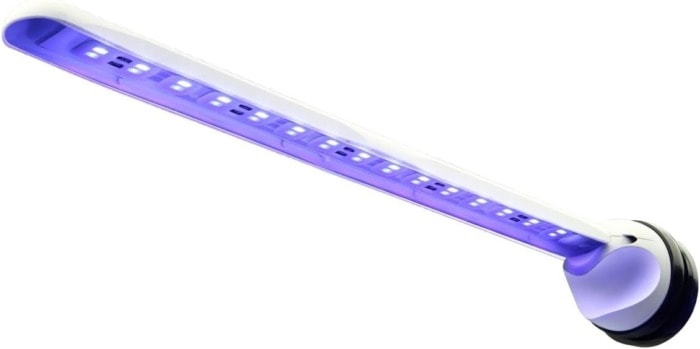
Click here to see the current price + more photos on Amazon.
I’m regularly testing new chaeto grow lights on my tanks and also gathering data from my friends who run tanks with sumps.
The Tunze Eco Chic 8831 happened to be one of the lights I tested recently.
Tunze, in general, are known as a brand for aquarium supplies that are a healthy mix of budget and premium items.
I’d say the Tunze Eco Chic 8831 is an upper-middle class refugium light.
So what I liked about this light was how well it grew my chaetomorpha algae, on top of being very versatile.
In just about 4 weeks the chaeto in my sump tripled in mass under the Tunze Eco Chic 8831 light.
To me, this is a clear sign the light works.
Keep in mind my system did not have some monstrous LED lights in the display tank.
That’s because the display tank had mainly LPS corals.
I don’t think that the Tunze Eco Chic 8831 is strong enough to be a good alternative to powerful regudium lights like the AI Prime and Kessil ones.
Prime and the Kessil’s are to be used on tanks with strong lighting in the display since they are very strong themselves.
Anyway, let’s assume you’re running a mixed reef with more LPS than SPS corals and you decided to give the Tunze Eco Chic 8831 a try.
You’d be surprised that this LED light is completely submersible.
I’ve seen some users mount it underneath their chaeto, on the bottom of the refigum.
It has cool magnetic mounts which I’m sure you’d find very convenient too.
But the kicker is that the Tunze Eco Chic 8831 actually comes with a 2-year warranty.
This is really rare for aquarium lighting in general and it pleases me that Tunze are so confident in their product.
In my opinion this chaeto LED light has a sturdy build, so I’d understand why Tunze are happy to offer a warranty.
Finally, make sure to actually get the 8831 because Tunze also offer an 8811 Eco Chic model which is a general light for saltwater aquariums and not refugiums (different spectrum).
Advantages:- 2-year warranty
- Grows chaeto great, has the right spectrum for that
- Sturdy build for the price
- Completely WATERPROOF and is SUBMERSIBLE
- Cool magnetic mount
- Not as strong as other premium refugium lighting like the Kessil and Prime (the Tunze is best used in a sump of an LPS-dominant mixed reef tank)
- You either hate or love the design, there’s no inbetween
This is a frequent question that gets asked and is one I had myself when I was first starting.
I try to keep budgetary concerns in mind when I write these out, as I know we can’t all spend a whole lot on tank accessories.
Still, it’s important to make sure you’re doing the best you can afford for your plants so let’s take a look at the pros and cons of a cheap refugium light:
A cheap refugium light will indeed get the job done. As long as the light it produces is in a good spectrum for your plants, and there’s enough of it, macroalgae such as Chaetomorpha will grow. What you will miss out on when going for the cheaper option, however, is certain things like light settings and customization options.
These aren’t that important if you’re a hands-on refugium owner, but you also may take a hit by shortened fixture longevity and light waste.
This, however, is not a rule. Most of them I’ve listed here, even the budget ones, don’t have this issue because they use newer energy-efficient light diodes.
In fact, a couple of the best I’ve tried are what many consider inexpensive options.
Fitting in your pockets doesn’t mean you have to take a hit on light quality.
Recommended Schedule and Daily Photoperiod
There’s a bit of debate on the web about the optimal light schedule for Chaeto and other macroalgae. I’m of the opinion a decent amount of it is misinformation and misunderstandings about how the plants operate.
Here’s a universally recommended schedule for a refugium light:
Aiming for a timing similar to natural photoperiods is the ideal way to set your refugium light schedule. This means something along the lines of 12 hours on, 12 hours off is generally considered the best.
Some people leave their lights on for 24 hours, but there’s not really any evidence to support this and it may actually stress out the plants, causing photoinhibition (slowed or stunted growth).
At the same time, anything less than 12 might not give your macroalgae enough to produce important nutrients for themselves.
Depending on the light you have, you can experiment with the schedule somewhat.
Additional Tips for a Thriving Reef Tank
Aside from a well-maintained refugium, there are other things that can be done to ensure proper filtration in your saltwater reef tank.
Some people swear by refugiums with blooming Chaeto as their sole form of aquarium filtration.
Yet every tank is different and in some cases, this may not be enough to lower your nitrates down to the desired level.
If you’re still worried about water clarity you should take a look into the best GFO or carbon media reactor units.
These will help tremendously with phosphate levels, which can quickly become an issue in overstocked or large reef aquariums.
They’re pretty simple, but somewhat underrated filter chambers, that house specific media and are excellent in these situations.
This can be a problem with water balance, such as overnutrification, but can also simply be a consequence of too much of the wrong light spectrum in your display tank.
To learn more about what spectrum to use for coral growth and which fixtures support it you can check my article on the best LED reef lights.
Chaeto mostly absorbs red and blue light, but the requirements for your display tank LEDs are different.
No one likes to feed unintended hair algae blooms in their saltwater aquarium.
FAQs

What is the best one for a refugium?
The best refugium light would be one that feeds your macroalgae light in the correct spectrum for its growth. These lights typically seem to emit pinkish light. Also, if you have strong lighting in the display tank you’d also want a relatively intense refugium light.
What is the best color spectrum to grow chaetomorpha?
Chaetomorpha is a macroalgae that mainly benefits from red and white light. Your refugium LED light should have dedicated red diodes to grow your chaeto well. Keep in mind that the light coming from these types of refugium lights looks pink and not completely red to the human eye.
Are there submersible ones for a refugium?
Yes, there are submersible LED refugium lights and aquarists use them to “bake” their macroalgae from both sides. The submersible light is usually positioned beneath the tumbling ball of macroalgae. The non-submersible classic refugium light would remain above the refugium or sump.
How to boots the growth of your chaeto algae?
Aside from a good refugium light, preferably an LED one, there’s no good way to boost the growth rate of your chaeto algae. Some aquarists add algae food supplements to the water column to stimulate the macroalgae’s growth. This does work but, in my opinion, defeats the purpose of having a chaeto refugium. We keep chaetomorpha precisely because we have excess organics in our reef tanks.
My Conclusion
I remember back when I was entering the marine tank hobby, most people didn’t recommend LED lighting for growing saltwater aquarium plants and macroalgae.
However, these lights have gone from relatively niche products into the go-to for marine plant growth, especially in sumps and refugiums.
I love watching the tech growing like this, and I’m completely convinced that LED lights over refugium tanks are the best for a giant Chaetomorpha yield.
I hope this helped, and Aquanswered all your questions, but do drop me a comment if you need some more guidance.

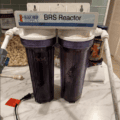
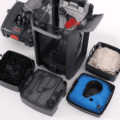

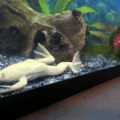
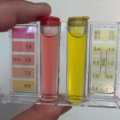
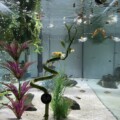

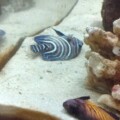


Thank you so much for this excellent article. Just enough of the science to understand the “why” one might consider investing in a fuge-focused light, and what to look for in said light – all without overwhelming a student who fought to stay awake through many physics lectures! Thanks also for explaining why K and watt claims aren’t as useful when considering lighting for our tanks.
No problem! Thank you so much for your kind words, this motivates us to keep sharing our love for the aquarium hobby. Take care and feel free to drop by again.